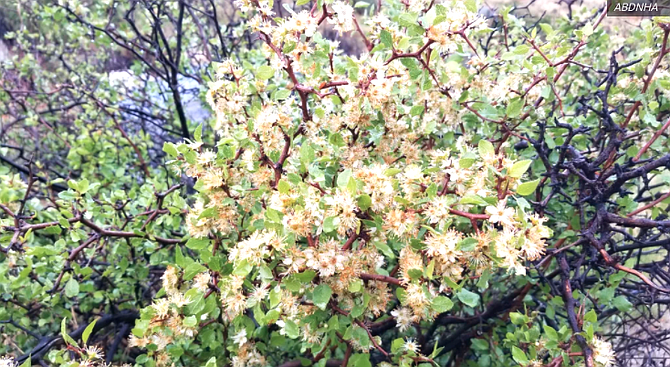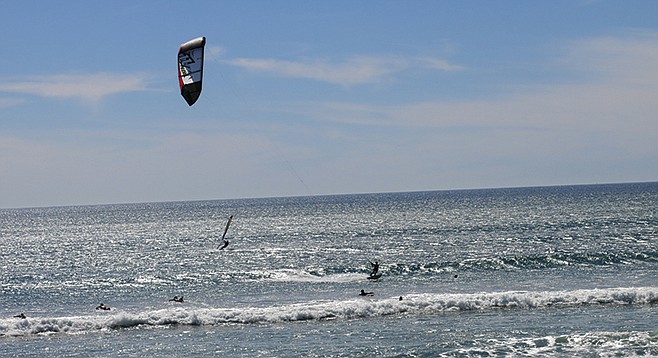 Facebook
Facebook
 X
X
 Instagram
Instagram
 TikTok
TikTok
 Youtube
Youtube

Ornamental Peach Trees, with radiant white and pink blossoms, are lighting up the manicured landscape around Sixth Avenue and Laurel Street in Balboa Park. These and other “stone-fruit” trees, with and without edible fruits, belong to the genus Prunus. Several native Prunus species contribute to San Diego County’s natural vegetation as well — among them, hollyleaf cherry, choke cherry, desert almond, and desert apricot. The desert apricot, about to bloom soon on the rocky hillsides of the Anza-Borrego Desert, attracts swarms of bees with its sweet-smelling nectar.

March Is the Proverbial Windy Month here in San Diego, as in most places. From midday to late afternoon, sun-warmed air expands and rises over the county’s interior, drawing in an influx of cool air from the coast to replace it. These afternoon sea breezes will continue at peak strength until well into the summer, providing dependable conditions for such sports as sailing, kite flying, and hang-gliding.
The Anza-Borrego Desert State Park should flower best in late February through early April, with peak blooms expected within two weeks in low-lying, warm areas like Borrego Valley, the Borrego Badlands, Coyote Canyon, and along Highway S-2 in the south end of the park. Among the many annually appearing wildflowers you’ll find in the low-lying areas are desert sunflower, dune primrose, lupine, desert chicory, sand verbena, and desert lily. On slightly higher ground and up along the hillsides, you’ll spot blooming brittlebush, chuparosa, ocotillo, apricot mallow, and more. Starting in March, several varieties of cactus should explode into bloom.
It’s Not Spring For Another Three Weeks. But the Spring Star, Arcturus, seems eager to jump into view. It rises above the east-northeast horizon only about an hour after full dark now, depending on your latitude. To see where to watch for this, find the Big Dipper as soon as the stars come out; it’s high in the northeast. Follow the curve of its handle down and around to the lower right by a little more than a Dipper-length. That’s the spot on the horizon to watch.
The above comes from the Outdoors listings in the Reader compiled by Jerry Schad, author of Afoot & Afield in San Diego County. Schad died in 2011. Planet information from SkyandTelescope.org.


Ornamental Peach Trees, with radiant white and pink blossoms, are lighting up the manicured landscape around Sixth Avenue and Laurel Street in Balboa Park. These and other “stone-fruit” trees, with and without edible fruits, belong to the genus Prunus. Several native Prunus species contribute to San Diego County’s natural vegetation as well — among them, hollyleaf cherry, choke cherry, desert almond, and desert apricot. The desert apricot, about to bloom soon on the rocky hillsides of the Anza-Borrego Desert, attracts swarms of bees with its sweet-smelling nectar.

March Is the Proverbial Windy Month here in San Diego, as in most places. From midday to late afternoon, sun-warmed air expands and rises over the county’s interior, drawing in an influx of cool air from the coast to replace it. These afternoon sea breezes will continue at peak strength until well into the summer, providing dependable conditions for such sports as sailing, kite flying, and hang-gliding.
The Anza-Borrego Desert State Park should flower best in late February through early April, with peak blooms expected within two weeks in low-lying, warm areas like Borrego Valley, the Borrego Badlands, Coyote Canyon, and along Highway S-2 in the south end of the park. Among the many annually appearing wildflowers you’ll find in the low-lying areas are desert sunflower, dune primrose, lupine, desert chicory, sand verbena, and desert lily. On slightly higher ground and up along the hillsides, you’ll spot blooming brittlebush, chuparosa, ocotillo, apricot mallow, and more. Starting in March, several varieties of cactus should explode into bloom.
It’s Not Spring For Another Three Weeks. But the Spring Star, Arcturus, seems eager to jump into view. It rises above the east-northeast horizon only about an hour after full dark now, depending on your latitude. To see where to watch for this, find the Big Dipper as soon as the stars come out; it’s high in the northeast. Follow the curve of its handle down and around to the lower right by a little more than a Dipper-length. That’s the spot on the horizon to watch.
The above comes from the Outdoors listings in the Reader compiled by Jerry Schad, author of Afoot & Afield in San Diego County. Schad died in 2011. Planet information from SkyandTelescope.org.
Comments